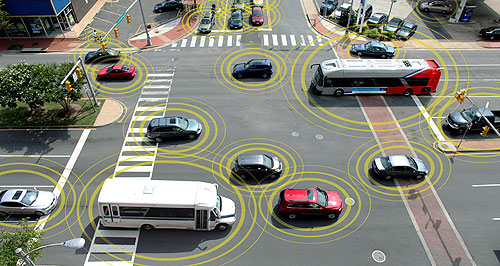Australia set to go with Europe on V2V
BY RON HAMMERTON | 11th Aug 2016

The proposed regulations pave the way for uniform vehicle-to-vehicle (V2V) and vehicle-to-infrastructure communications across the country, bringing driverless vehicles and sophisticated traffic management systems to cut greenhouse gases and reduce the road toll one step closer.
The United States has also adopted the 5.9 GHz band for C-ITS, although some channelling differences will exist.
Japan, on the other hand, has adopted another band, meaning that unmodified “grey import” Japanese vehicles broadcasting on the incorrect band in Australia will be breaking Australian law by interfering with other wireless communications.
Inter-vehicle communications means vehicles can, for example, warn each other of dangerous traffic situations, such as a crash, and thus avert a more catastrophic problem.
The government body that controls such radio bandwidth decisions here, the Australian Communications and Media Authority (ACMA), has been working with various ITS stakeholders, including the Federal Chamber of Automotive Industries (FCAI), on the issue since 2009.
It has now issued a consultation paper on the proposed regulations and called for submissions from interested parties by September 23.
ACMA says Australia needs to lock in the new standards soon, as cars fitted with such communications systems could be rolling from European production lines as early as next year, potentially ending up on the Australian market.
FCAI chief executive Tony Weber welcomed the move, saying it was an essential first step in the development of an integrated, automated and connected driving network in which vehicles would be able to digitally exchange information with each other while also communicating with the road network and surrounding infrastructure.
“A national approach is vital to ensure C-ITS delivers optimal benefits no matter where in Australia you drive,” he said.
“Properly funded, well-engineered and collaboratively supported, a world-class C-ITS in Australia will save hundreds of lives on our roads every year, optimise our investment in infrastructure, reduce vehicle greenhouse gas emissions, shrink our commuting times and in doing so, relieve a huge amount of pressure from our emergency services and our hospital system.”Mr Weber said the proposed regulations ensured a unified approach to vehicle communications.
“This confirms that the Australian C-ITS standards will be the same as those used in the EU,” he said.
“Any vehicles operating on other frequency bands, such as those built specifically for use in the Japanese domestic market, will not be able to communicate with ours.
“And what is equally as important, any vehicles imported that operate on different standards, will illegally interfere with a range of other services here such as toll roads and mobile phones.
“This consultation paper places a digital marker from which our C-ITS will mirror those being planned and implemented by Europe.”All vehicle companies will be obliged to adopt the 5.9 GHz band so that all autonomous or semi-autonomous vehicles can communicate.
This means that Japanese-built vehicles from manufacturers such as Toyota, Mazda and Subaru will have to be fitted with the Australian-standard system, not the Japanese version.
Such communications systems will be high on the agenda of the ITS World Congress to be held in Australia in October.